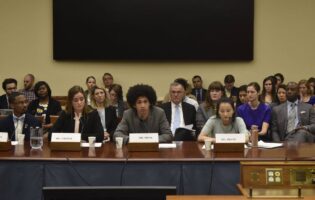Why is There No PISA Shock in the U.S.? A Comparison of German and American Education Policy
When the OECD’s Programme for International Student Assessment (PISA) released the results from its third cross-country comparison of the knowledge and skills of high school students in early December 2007, a contentious and hysterical debate about education was (again) unleashed in Germany. PISA is the largest international comparative education study surveying the competencies and skills of fifteen and sixteen year-olds in reading, math, and science in some fifty-seven countries. It began in 2000 and has been conducted every three years with results being published the following year. The first PISA report, released in December 2001, caused a “shock” in Germany: the country that prided itself on its education system, on its contributions to western science and philosophy – that had produced Einstein, the von Humboldt brothers, Heisenberg, Goethe, Nietzsche, and Marx – ranked at the lower end of the comparative spectrum! German students did poorly in all of the three tested subjects. Whereas Germans had always assumed tacitly that they were the world’s leader in education, this international data was now showing that their education system was well below average in the twenty-first century.
Since 2001, education has been one of the most important election themes in Germany, OECD testing items have received high coverage in the media, and the term “PISA” itself has become a synonym for testing, ranking, and rating. There is even a new TV show called “PISA – the Test” being launched on German television. The post-PISA debates in Germany cut straight to the chase: at a time when children are in scarce supply and knowledge, one of the world’s most valued resources, is economically critical, does not the provision of extra support for the education of children from poor families become a matter of economic imperative as well as social equity? Would it boost the overall education level if children from immigrant families were targeted with special programs designed to ensure their full inclusion in all three tiers of the educational system? Do we need to launch a new kind of pre-school and kindergarten that provides more than just childcare for children between the ages of three and six – in other words, make profound changes in the relationship between family and the school system? In response to PISA, these questions are now an integral part of national politics. Even the “sacred cow” of the German educational system, its three-tiered school system, is being scrutinized, questioned, and, in some of the Länder, reformed.
In the U.S., however, the three cycles of the PISA study and their results have gone largely unnoticed. The general public and the media did not pay attention to this study and its results – despite the fact that the U.S. performed as badly as Germany, being ranked below the average of the participating countries. In fact, the U.S. scored worse in the 2006 study than it had in the previous two studies; in the latest PISA study, for example, the U.S. ranked only twenty-fourth in mathematics among the thirty OECD member states. But no one seems to be concerned: out of eight major U.S. daily and weekly newspapers, only eight articles over the period of 2001 to 2008 actually covered PISA at all – and of these eight articles only three deal with the poor results of U.S. students. (1) During the same time period the German daily newspaper Süddeutsche Zeitung, for example, published 253 articles. Why did the PISA study not have the same effects in the U.S. as it did in Germany? Or to put it differently: why is there no PISA shock in the U.S.?
Unlike in Germany, reforms in the U.S. aiming at improving the quality of education began in the early 1980s when the government enlisted a national commission to conduct a study of the American educational system. In 1983, “A Nation at Risk: Imperatives for Educational Reforms” found devastating results: with 23 million adults and 17 percent of juveniles being illiterate, the American educational system was abysmal. The report triggered broad public concern about the quality of education, identifying the need for the monitoring of schools, standards, and teachers. The “Great School Debate” (2) soon attracted the attention of the highest political officials in the country; during the height of the Cold War, President Ronald Reagan considered this state of affairs a national security risk and made school reform a first priority of his administration. Since then, education matters have been on the top end of each presidential administration’s list of reforms. This year’s presidential elections are the first since the 1980s where other issues, in particular the war against terrorism and the state of the economy, outrank education in terms of importance.
In a way, the U.S. thus had its “education shock” earlier than Germany. And, unlike Germany, which was hit by an external international organization, the U.S. “shock” was self-made in the sense that America itself had commissioned a review on the state of education. The country has since gone through a series of educational reforms aiming at creating standards, providing for accountability, enabling school choice, and improving the quality of teaching, to name the major reforms. The irony, however, is that it was in fact the U.S. that provided the inspiration for the PISA study, which impacted other countries’ education policies far more than it did U.S. policies. When “A Nation at Risk” hit the U.S., the Reagan administration not only started domestic reforms, but it also wanted international comparative data on the state of education in the industrialized world in general. The idea for an international comparative study was then brought to the OECD. Being the major financial contributor to the OECD’s budget for education, the U.S. pushed the international organization to significantly change its work in education and compile internationally comparable statistical data. In response to tremendous pressure from the side of the U.S., the International Indicators of Educational Systems (INES) project was established in 1988 and started to produce regular publications on education indicators – of which the PISA study is the latest offspring. (3)
Despite the reforms of the last twenty-five years since “A Nation at Risk” was published, schools in the U.S. have improved only to a limited extent. Thus, the various low PISA scores for the U.S. did not create a shock to the country, even though it is basically known that the U.S. education system still needs improvement. Or to put it into the words of one interviewee: “it would have been a [positive] shock if the U.S. had performed better in the PISA study” (Interview #1, 2008).
—————————————————
Footnotes:
1. The newspapers examined include: The New York Times, Newsweek, International Herald Tribune, The Washington Post, USA Today, The Wall Street Journal, and The Los Angeles Times. The research was conducted with Factiva, a database for newspaper articles. Keywords for this search were ‘OECD’ and ‘PISA.’
2. Gross, Ronald and Gross, Beatrice (eds.) (1985): The Great School Debate, New York: Touchstone.
3. For more details on the OECD’s role in education, see Martens, Kerstin (2007): “How to Become an Influential Actor – the ‘Comparative Turn’ in OECD Education Policy,” in: Kerstin Martens, Alessandra Rusconi & Kathrin Leuze (eds.), New Arenas of Education Governance – The Impact of International Organisations and Markets on Education Policy Making, Palgrave Macmillan, 40-56.
—————————————————
Kerstin Martens is Assistant Professor of International Relations at the University of Bremen. This essay is the result of a research project carried out as a DAAD/AGI Fellow at the American Institute for Contemporary Germany Studies in August-September 2008. Twelve semi-structured interviews on the state of education policy in the U.S. were conducted with politicians, scholars, education specialists, and media representatives. The author would like to thank Jackson Janes and his team from AGI for their support in conducting this research. This study supplements the research project on “Internationalization of Education Policy” at the University of Bremen in which new international dynamics in the field of education policymaking and their effects on nation-states and individuals are explored. The project is part of the Collaborative Re-search Center on “Transformations of the State” at the University of Bremen and funded by the German Research Foundation (DFG). Kerstin Martens can be reached at kerstin.martens@sfb597.uni-bremen.de.
—————————————————
AGI would like to thank the German American Academic Exchange Service (DAAD) for the support of this essay. This essay appeared in the October 3, 2008, AGI Advisor.









